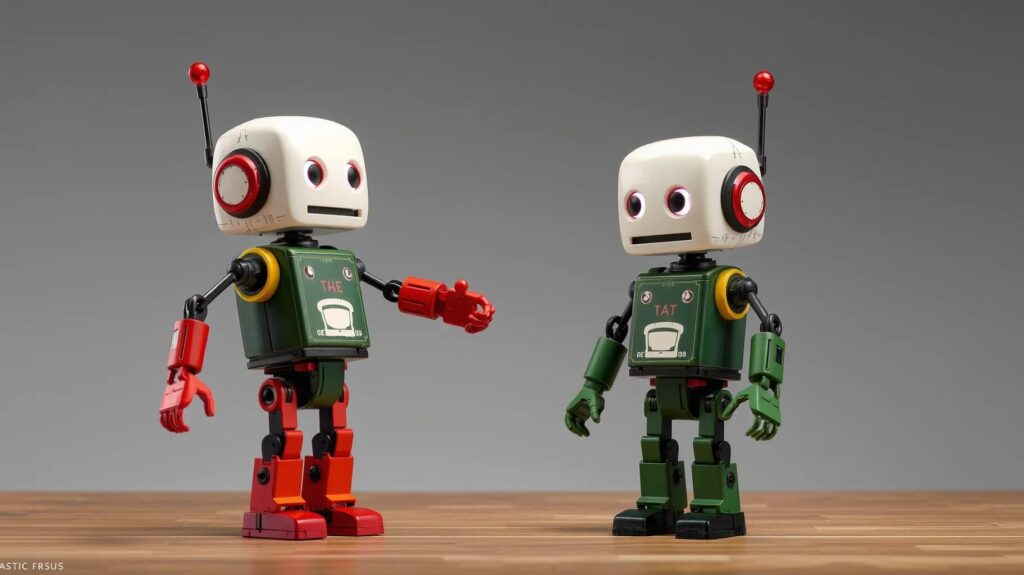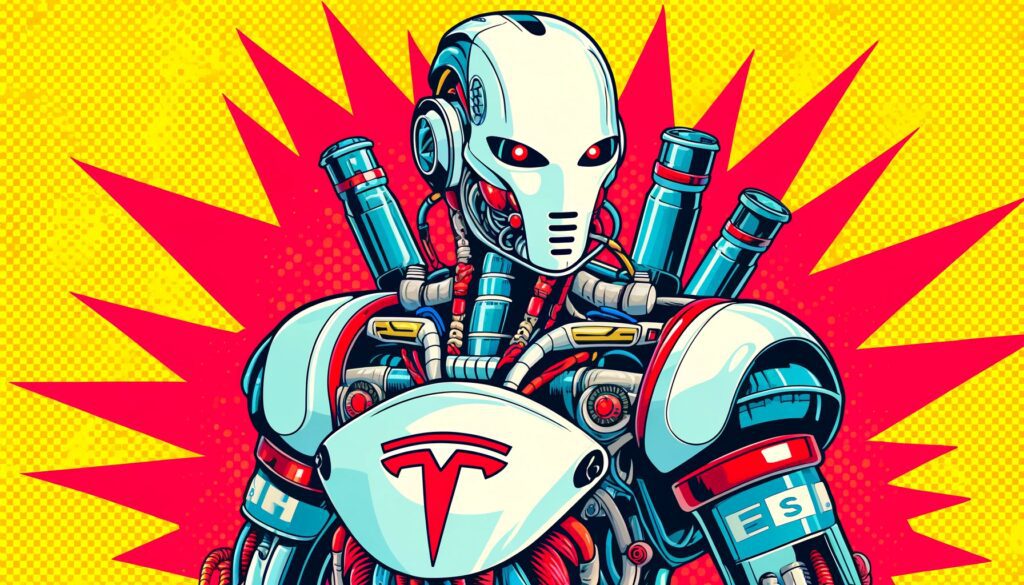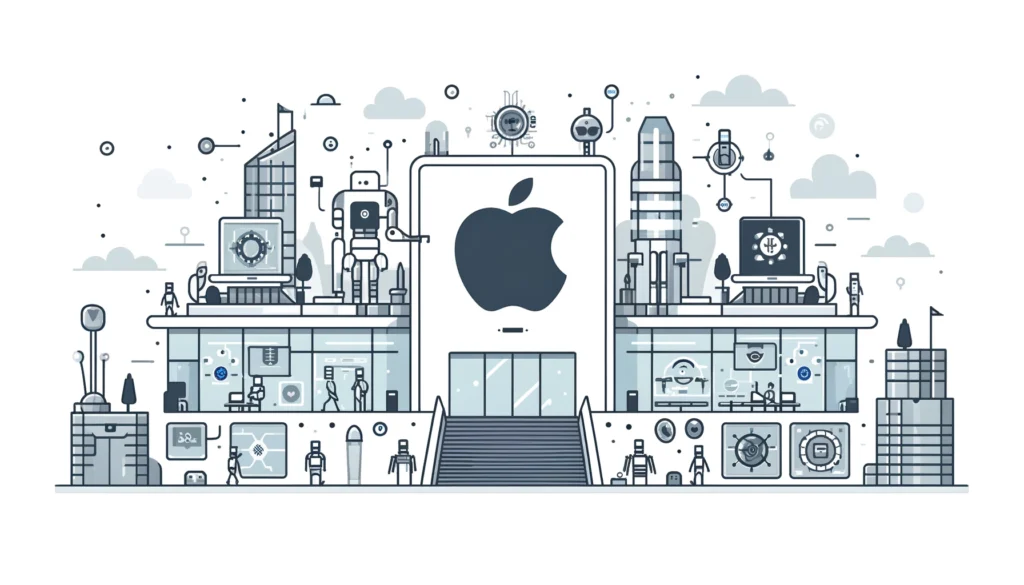
The world of DIY tech has reached exciting new heights, with AI-driven projects bringing smart home automation within reach.
Today, even beginners can dive into DIY AI projects that transform ordinary tasks, automate routines, and even take on advanced functionalities like monitoring, security, and climate control. Whether you’re tech-savvy or new to AI, these projects are both manageable and rewarding. Below, we’ll explore different DIY projects to help you start creating a smart, interconnected home.
Getting Started with DIY AI for Home Automation
Basic Tools and Tech to Start DIY AI
Starting with DIY AI projects doesn’t have to be intimidating. Most projects require only a few essentials:
- Raspberry Pi: A mini-computer used in countless DIY setups. Perfect for processing data and running lightweight AI models.
- Arduino: Ideal for controlling sensors and actuators, making it great for smaller projects.
- Sensors and Actuators: Temperature, motion, humidity, and light sensors can add intelligence to your environment.
- Voice Assistants: Consider using Google Assistant or Alexa, which integrate well with custom AI solutions.
You don’t need to be a programmer to get started. Online resources and guides can simplify each project step, making the learning curve manageable.
Choosing the Right AI Platform
For DIY AI projects, choosing the right platform is essential for a smooth experience. Some popular options include:
- TensorFlow Lite: Perfect for lightweight AI models that work with IoT devices.
- OpenAI API: Allows text-based AI integrations, ideal for chatbots or automation.
- Home Assistant: An open-source home automation platform that integrates with nearly any smart device, ideal for creating an AI-centered smart home.
With these platforms, even complex automations become accessible for hobbyists. Some also have great communities, so support is usually a click away.
Building a Basic Smart Home Hub
Creating a central smart home hub can be the heart of your DIY setup. Using a Raspberry Pi with Home Assistant, you can control everything from lights to security systems.
- Install Home Assistant on your Raspberry Pi.
- Connect devices like smart bulbs, security cameras, and door sensors.
- Use a voice assistant like Google Assistant to enable voice control for convenience.
From here, you can create “recipes” that link different actions together. For instance, setting your lights to turn on at sunset or your thermostat to adjust when the house is empty.
Customizing Voice Control with AI
Voice control is often the entry point into AI-powered home automation. While Alexa and Google Assistant offer a lot of features, custom voice commands can take automation further.
- Use OpenAI’s Whisper to create custom commands.
- Program the system to recognize specific voices, ensuring security and personalization.
- Link voice commands to physical actions, like unlocking doors or turning on appliances.
By setting up your own voice recognition system, you control the process without relying on big tech ecosystems, adding a layer of privacy and control.
Intermediate DIY AI Projects to Level Up Your Smart Home

Creating an AI-Powered Security System
Home security is a high priority, and with AI, it’s easier than ever to create a custom security system that’s both reliable and intuitive.
- Camera Surveillance: Connect a camera module to your Raspberry Pi. Use OpenCV, a popular AI library, to add facial recognition.
- Motion Detection: With a simple motion sensor, set up notifications for unexpected movement.
- Real-Time Alerts: Program the system to send SMS or push notifications if it detects unfamiliar faces.
This setup is ideal for people who want instant alerts and the ability to monitor their home remotely.

Install Camera Hardware: Set up a camera, like the Raspberry Pi Camera Module.
Set Up OpenCV: Install and configure OpenCV for facial recognition.
Integrate Motion Sensors: Connect and configure motion sensors to detect movement.
Configure Alert Notifications: Set up notifications (e.g., SMS or email) for alerts.
Test System: Verify the functionality of detection and notification.
Smart Lighting with AI
Smart lighting is an enjoyable project, combining energy efficiency with added ambiance in your home. Using AI, you can tailor lighting based on activity, time of day, or even your mood.
- Automated Light Adjustments: Use motion sensors to adjust lighting when you enter or leave a room.
- Customizable Light Scenes: Set different lighting scenes for activities like reading, watching movies, or entertaining guests.
- Voice-Controlled Lights: Link lights to a voice assistant, allowing for hands-free control over brightness and color.
Not only is smart lighting a fun DIY project, but it’s also a great way to save on energy costs and add convenience.
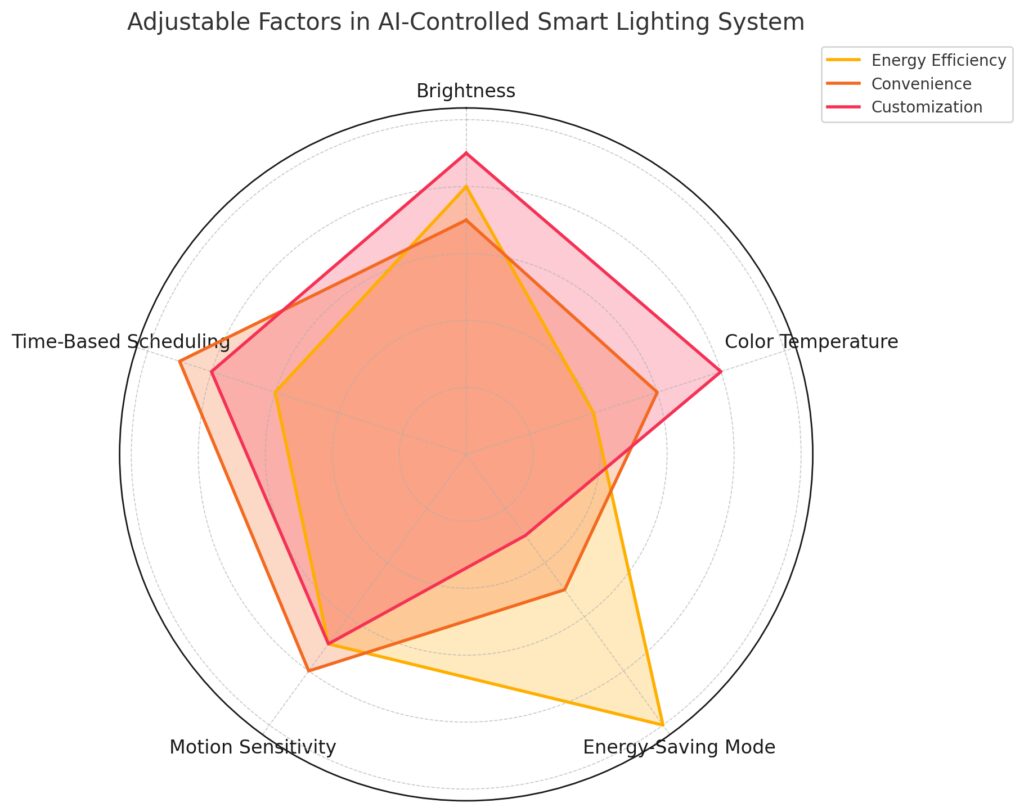
Factors: Brightness, Color Temperature, Energy-Saving Mode, Motion Sensitivity, and Time-Based Scheduling.
Impact Levels:Energy Efficiency: High impact from energy-saving mode and moderate impact from motion sensitivity.
Convenience: Enhanced by factors like time-based scheduling and motion sensitivity.
Customization: Driven by adjustable brightness, color temperature, and scheduling.
Temperature Control with AI
Imagine having a climate control system that learns your preferences and adjusts automatically. Using temperature sensors and AI, you can create a comfortable, efficient environment.
- Place Temperature Sensors around your home.
- Program the sensors to communicate with your thermostat.
- Use machine learning to adjust the thermostat based on your daily routines.
By tracking your routines, an AI-powered thermostat can anticipate your comfort needs, adjusting before you even realize it’s warm or chilly.

Time of Day: AI checks if it’s day or night.
Current Temperature: Evaluates if the temperature is above, within, or below the preferred range.
User Preferences: Considers if the user prefers a warmer or cooler environment.
AI Adjustments:Heating: Activated if it’s cool and the user prefers warmth.
Cooling: Activated if it’s warm or if the user prefers a cooler setting.
Maintain Temperature: Keeps the current setting if within range or the user is neutral.
DIY AI Voice Assistant
Creating a personalized AI assistant is a fascinating way to bring a touch of science fiction into your home. Using an open-source platform, you can build a voice assistant tailored to your needs.
- Custom Commands: Teach the assistant to handle specific commands for your smart home devices.
- Integrate with Home Assistant: Connect with Home Assistant for even more control.
- Conversation Training: Use NLP (natural language processing) to improve response accuracy.
This assistant can help you control the environment and streamline daily tasks, offering a hands-free experience across your connected devices.
Advanced DIY AI Projects: The Future at Home
AI-Powered Gardening System
For those with a green thumb, AI can help turn a garden into a smart, self-sustaining ecosystem. By combining sensors and automation, you can help your plants thrive.
- Soil Moisture and Light Sensors: Monitor when your plants need water or more sunlight.
- Automated Watering System: Use the data from sensors to automatically water your plants when necessary.
- Climate Control: For indoor gardens, use temperature and humidity sensors to control the environment precisely.
With AI handling the details, you can enjoy gardening without the constant upkeep.
Home Health Monitoring System
AI-driven health monitoring systems in your home can track various health metrics, offering peace of mind and added safety.
- Heart Rate and Blood Pressure: Use wearable devices or sensors to track vital signs.
- Activity Detection: Detect changes in movement or activity patterns to flag potential health issues.
- Air Quality Monitoring: Use air quality sensors to alert you if pollutant levels rise.
This system is especially useful for families with elderly members, providing alerts and data that help you proactively manage health.
Energy Efficiency Optimization
Optimizing energy usage in your home is both eco-friendly and cost-effective. Using AI, you can monitor and reduce energy waste by tracking usage patterns.
- Smart Meter Integration: Connect a smart meter to your system to monitor energy usage.
- AI-Powered Predictions: Use machine learning to predict when high-energy appliances can be used cost-effectively.
- Automatic Appliance Control: Shut down devices when they aren’t needed, reducing overall energy consumption.
An AI-powered energy management system can drastically cut down energy bills while keeping the environmental footprint low.
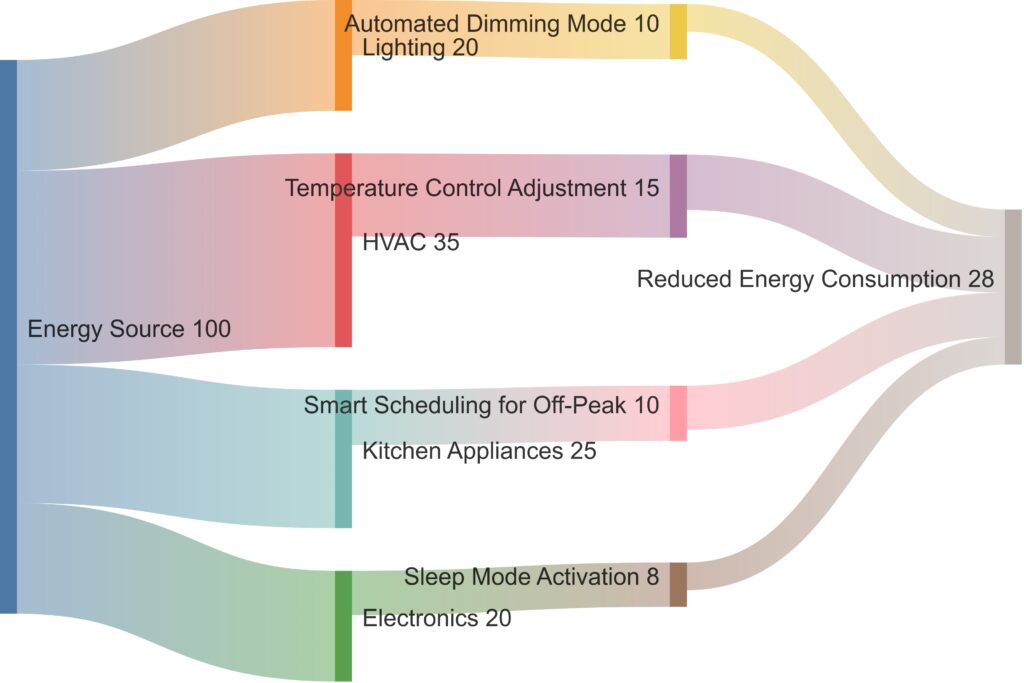
Major Energy Consumers: Lighting, HVAC, Kitchen Appliances, and Electronics.
AI Optimization Measures:Lighting: Automated dimming mode reduces consumption.
HVAC: Temperature control adjustments lower energy use.
Kitchen Appliances: Scheduled to run during off-peak hours.
Electronics: Sleep mode activation to save power.
Each optimization path leads to Reduced Energy Consumption, showing how AI effectively redistributes and manages energy usage.
Automated Pet Care System
For pet owners, automated pet care is a perfect balance of convenience and peace of mind.
- Automated Feeders: Program feeding times, so your pets are always well-fed, even when you’re not home.
- Pet Activity Monitoring: Use motion detectors and cameras to ensure pets stay safe and active.
- Health Monitoring: Track your pet’s activity, feeding habits, and weight, so you’re alerted to any changes that may indicate health issues.
With an automated pet care system, you ensure your pet’s wellbeing, even on the busiest days.
Expanding Your AI-Powered Home with Advanced Projects
Smart Home Entertainment System
A smart entertainment system can turn movie nights, parties, or daily routines into immersive experiences. AI adds a layer of customization, automating everything from sound to lighting.
- AI-Driven Recommendations: Link AI platforms like TensorFlow Lite to track viewing habits and recommend shows or music based on your preferences.
- Automated Lighting and Sound: Use voice commands to adjust lighting, volume, or even trigger surround sound modes.
- Voice-Controlled Media: Integrate a voice assistant to control music, movies, or even turn your TV on and off hands-free.
Imagine a setup where the lights dim and the surround sound activates the moment you press play. This AI-powered system makes entertainment more convenient and tailored to your tastes.
AI-Enhanced Home Office Setup
With more people working remotely, smart home office automation can optimize productivity and comfort. This setup is ideal for anyone looking to create a workspace that adapts to their needs.
- AI-Powered Lighting and Temperature Control: Set your workspace lighting and temperature based on time of day and outdoor conditions, keeping you comfortable throughout your workday.
- Voice-Activated Task Management: Use voice commands to add tasks, set reminders, or manage meetings, keeping your hands free and focused.
- Noise-Canceling Environments: Install smart speakers that play white noise or cancel out background sounds, creating a more productive environment.
Whether you’re taking calls or working on complex projects, an AI-enhanced office helps you stay focused and efficient.
Personalized Home Gym with AI Coaching
For fitness enthusiasts, an AI-powered home gym can be an invaluable tool. Using cameras, motion sensors, and voice commands, you can get real-time feedback and motivation.
- Form Tracking with AI: Use a camera and AI software to analyze your form in real-time, offering corrective feedback.
- Automated Workout Routines: Track your progress and adapt workouts based on your goals, providing a personalized fitness plan.
- Voice-Activated Workouts: Start workouts or request new exercises with voice commands, keeping the momentum going without interruptions.
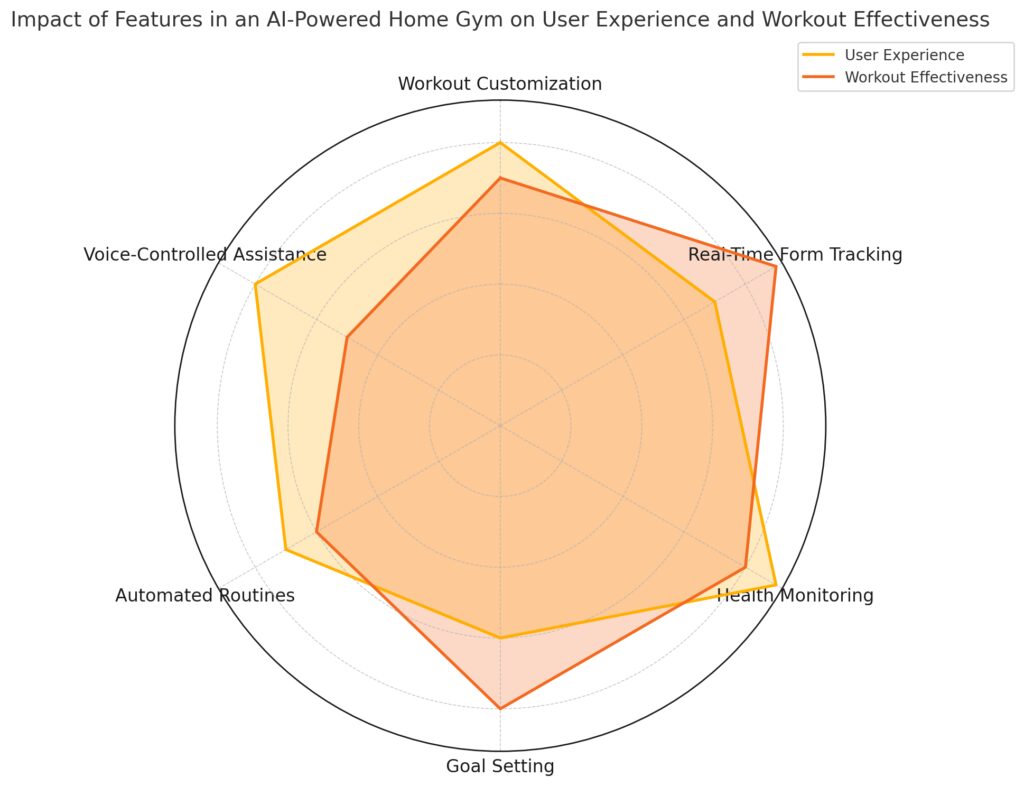
Features: Include workout customization, real-time form tracking, health monitoring, goal setting, automated routines, and voice-controlled assistance.
Impact Levels:User Experience: Health monitoring and voice-controlled assistance have high impacts.
Workout Effectiveness: Real-time form tracking and health monitoring contribute significantly.
This visualization highlights how each feature affects the overall user experience and workout effectiveness, showing areas where AI functionalities enhance gym performance and engagement.
AI-powered coaching can make your workouts safer and more effective, pushing you toward your fitness goals with real-time guidance.
AI for Home Maintenance and Repairs
Home maintenance can be a chore, but AI solutions can make it a lot easier. From leak detection to appliance monitoring, AI can help keep your home running smoothly and prevent costly repairs.
- Smart Leak Detection: Install moisture sensors in areas prone to leaks, such as under sinks or near appliances. The system can alert you to potential problems before they escalate.
- Appliance Monitoring: Use energy monitoring devices that alert you if an appliance’s power usage spikes, which could signal a malfunction.
- Predictive Maintenance: Some AI platforms can predict when appliances are due for maintenance based on usage patterns, keeping your home running smoothly.
Preventive maintenance becomes a breeze, ensuring your home is always in top condition.
Building a Sustainable Smart Home with AI Automation
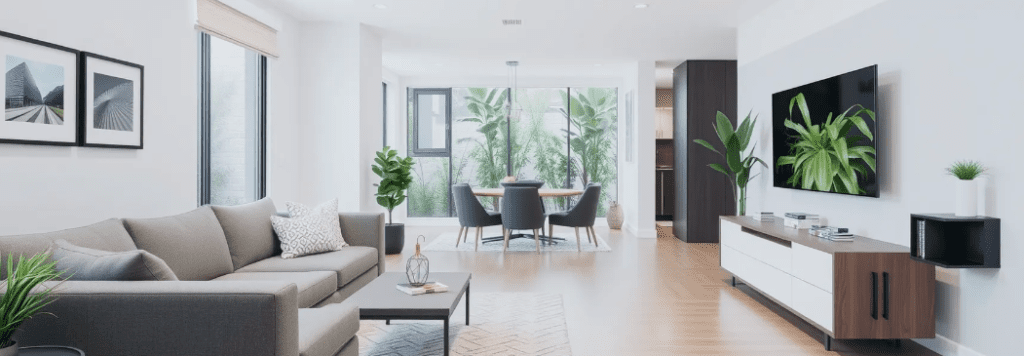
AI-Optimized Water Usage System
Water conservation is a crucial part of sustainable living, and an AI-optimized water system can make it easy to reduce waste without sacrificing comfort.
- Smart Irrigation: Link soil moisture sensors to your garden’s irrigation system. The AI can monitor weather forecasts and adjust watering schedules automatically.
- Flow Meters: Use smart flow meters to monitor water usage and detect leaks, helping you catch problems early.
- Water Conservation Suggestions: Receive insights and suggestions from your AI system about where you might be overusing water.
This type of system makes it simple to conserve water, save on bills, and support sustainable practices.
Solar Power Optimization with AI
For those who have installed solar panels, AI can optimize energy use, making the most of this renewable resource.
- Energy Storage Predictions: AI can help predict energy generation and usage patterns, suggesting the best times to store energy or use it directly.
- Appliance Scheduling: Automate energy-intensive appliances to run during peak sunlight hours, maximizing the efficiency of your solar power.
- Energy Insights: Get regular reports on energy savings, generation levels, and ways to improve overall efficiency.
With AI, managing solar power becomes more efficient, helping you achieve a lower environmental impact and reduced utility bills.
Waste Management and Recycling with AI
Automating waste sorting and recycling within the home is possible with AI and a bit of creativity. This project could be perfect for eco-conscious households wanting a smarter approach to waste.
- Image Recognition for Sorting: Use a camera and image recognition to sort waste automatically, making recycling a breeze.
- Compost Management: For composting, AI sensors can monitor moisture and temperature levels, ensuring a healthy compost environment.
- Waste Reduction Insights: Track your waste habits and get personalized insights into ways you can reduce waste.
This project brings eco-friendly practices right into your kitchen, making recycling and composting easier than ever.
AI-Powered Air Quality Management
Maintaining good air quality indoors is essential, and AI can help you monitor and adjust for better health and comfort.
- Air Quality Sensors: Place sensors throughout your home to track levels of pollutants, allergens, or CO2.
- Automated Air Purifiers: Connect purifiers to your AI system, so they turn on when pollutants reach certain levels.
- Humidity Control: Adjust humidity automatically to optimal levels, keeping the environment comfortable and healthy.
This setup is especially useful for homes with pets, allergies, or respiratory issues, ensuring that everyone breathes easier.
Bringing AI Automation to the Outdoors
AI-Powered Smart Outdoor Lighting
Outdoor lighting can add both security and ambiance to your home, and AI allows for customized lighting based on real-time data.
- Motion-Activated Lighting: Use motion sensors to light pathways when someone approaches, adding both convenience and safety.
- Ambient Light Adjustments: Program lights to adjust based on sunset and sunrise, ensuring they’re only on when needed.
- Weather-Based Adjustments: Integrate with a weather service to change lighting during heavy fog or rain for extra visibility.
AI-powered lighting adds a sense of security while keeping energy consumption in check.
Intelligent Pool Management System
For homeowners with a pool, AI can simplify pool maintenance and keep water levels and quality optimal with minimal effort.
- Water Level Control: Automatically adjust water levels based on rainfall and usage, ensuring your pool stays in top condition.
- Chemical Monitoring: Use pH and chlorine sensors to maintain safe water chemistry levels.
- Pool Temperature Control: AI can track outdoor temperatures and adjust the pool temperature, creating a comfortable swimming experience without manual input.
This AI-powered pool management system ensures your pool stays ready for use, cutting down on maintenance time and costs.
Outdoor Security and Surveillance
Outdoor security is an excellent area for AI-driven enhancements. By using cameras and motion sensors, you can set up an intelligent surveillance system for added peace of mind.
- Facial Recognition for Trusted Visitors: Program facial recognition software to differentiate between known and unknown faces.
- Alert System: Receive alerts if unusual movement or faces are detected, with the option to stream video to your device.
- Intelligent Lighting: Link lights to turn on when motion is detected, deterring intruders and enhancing security.
With AI, your outdoor spaces are monitored and safe, adding a powerful layer of security to your home.
AI-Driven Garden Landscaping
For those with larger landscapes or gardens, AI can streamline gardening and maintenance, transforming outdoor spaces into sustainable ecosystems.
- Soil Analysis: Use sensors to track soil pH and nutrient levels, helping you choose the best plants for your soil.
- Weather-Responsive Watering: Adjust watering schedules based on weather forecasts to save water.
- Seasonal Planting Suggestions: AI can recommend planting schedules based on your region’s climate, creating a low-maintenance, beautiful landscape.
This landscaping approach ensures your garden thrives with minimal intervention, making your outdoor space as smart as your home.
Exploring AI-Enhanced Daily Living in a Smart Home
AI-Driven Personal Assistant for Routines and Reminders
One of the most practical uses of AI in a smart home is creating a personal assistant that manages daily routines. This project takes the convenience of voice assistants a step further by personalizing reminders, routines, and even actionable insights into daily activities.
- Routine Management: Schedule daily tasks like watering plants, feeding pets, or prepping the coffee maker each morning. The AI assistant can handle these reminders based on a customized schedule.
- Reminders and Notifications: Set reminders for medications, important meetings, or household tasks. You can configure notifications through voice, text, or smart devices like your smartwatch.
- Behavior Analysis: By tracking routines, the assistant can learn your schedule over time, making proactive recommendations, like suggesting an earlier alarm if there’s heavy traffic on a route you regularly travel.
With this project, you have a true virtual helper, keeping you organized and on schedule with minimal effort.
AI-Supported Meal Planning and Kitchen Automation
Smart kitchen automation is a growing trend that can streamline meal planning, grocery shopping, and even cooking. This project is ideal for those who want a more organized kitchen experience.
- Smart Inventory Management: Using a camera and AI, track the contents of your pantry and fridge, helping you stay on top of items you need to buy.
- Automated Meal Planning: Based on your dietary preferences and available ingredients, the AI can suggest recipes, making it easier to plan meals.
- Cooking Assistance: Connect with a voice assistant to guide you step-by-step through recipes, adjust cooking times based on the size or type of ingredients, or even suggest modifications based on dietary needs.
AI-driven kitchen automation turns cooking into a more enjoyable, stress-free activity, perfect for meal preppers, busy families, or anyone looking to add some ease to their cooking routine.
Smart Sleep Monitoring and Optimization
AI can contribute significantly to improving sleep quality by creating a sleep-conducive environment and tracking key sleep data. With a few sensors and some smart automation, you can build a system that learns your sleep patterns and makes recommendations to help you rest better.
- Sleep Tracking Sensors: Use sensors or wearable devices to monitor sleep phases, breathing, and movement during the night. The AI can identify patterns over time and recommend adjustments.
- Smart Lighting and Temperature: Set lights to gradually dim and room temperature to adjust as bedtime approaches, creating a calming environment.
- Soundscapes for Relaxation: Automatically play soothing sounds or white noise based on your sleep habits to encourage restful sleep.
By analyzing your sleep quality, this system helps you make data-driven improvements, leading to better health and productivity.
AI-Powered Home Wellness and Mood-Boosting Systems
Wellness and self-care are central to a balanced life, and AI can support this by creating a mood-enhancing atmosphere. This project focuses on elevating wellness through personalized ambiance adjustments.
- Mood Lighting and Scent Diffusers: Set the lighting and scent in your home to match your mood or time of day. For instance, warm lights and lavender scents in the evening can promote relaxation.
- Meditation and Relaxation Assistance: Link with a voice assistant to provide guided meditation sessions, breathing exercises, or mindfulness reminders.
- Music and Sound Therapy: Play mood-enhancing music or nature sounds based on your mood, tracked by sensors or a wearable device, creating a stress-free space for relaxation.
These mood-boosting systems help you create a space that feels refreshing and restorative, transforming your home into a personal sanctuary.
Using AI to Create a Safer, More Accessible Home

AI-Based Fire and Carbon Monoxide Detection
Traditional fire alarms and CO detectors save lives, but AI-enhanced detection systems can take safety to the next level by anticipating dangers more effectively.
- Real-Time Alerts: Use advanced sensors and AI algorithms to detect smoke, heat, or gas changes more accurately, sending alerts to your devices instantly.
- Preemptive Warnings: By analyzing temperature or air quality changes, the AI system can warn of potential fire hazards before they escalate.
- Voice Alerts: Integrate voice alerts that guide residents to safety, especially helpful for children or individuals with disabilities.
Enhanced detection systems are ideal for keeping families safe and providing an additional layer of protection that goes beyond traditional smoke alarms.
Home Accessibility Enhancements with AI
For individuals with disabilities or older adults, AI can make the home more accessible and easier to navigate. This project is invaluable for anyone looking to make a home environment that adapts to diverse needs.
- Voice Commands for Accessibility: Connect voice commands to various devices to make controlling lights, appliances, and other systems easier for those with limited mobility.
- Real-Time Assistance: Set up a video and audio monitoring system that can alert caregivers if the system detects a fall or a lack of movement for a concerning period.
- Customized Reminders: AI can provide daily reminders for medication, hydration, or other health routines, assisting users with memory challenges.
By integrating accessibility features into the smart home, AI can support independent living and peace of mind for family members.
AI for Home Security with Enhanced Privacy
Home security systems often rely heavily on constant monitoring, but AI offers a more privacy-friendly approach by only recording when needed.
- Facial Recognition and Anomaly Detection: Use AI-based cameras to recognize familiar faces and only trigger alerts for unfamiliar ones, reducing unnecessary recordings.
- Privacy Mode: Schedule cameras to switch to privacy mode when family members are home, only activating during designated hours or under specific circumstances.
- Geofencing for Security: Geofencing can automatically activate the security system when everyone leaves and disarm it when someone arrives, maintaining a seamless security experience.
This approach keeps privacy top of mind while enhancing home security, balancing safety with comfort.
AI-Assisted Emergency Response System
A well-rounded emergency response system is a valuable addition, especially for households with elderly members or individuals with health conditions. AI can help by creating a system that identifies and responds to emergencies promptly and accurately.
- Fall Detection Sensors: Use motion detectors and wearables to recognize sudden falls, automatically triggering alerts.
- Health Tracking and Alerts: Track vital signs through wearable devices, prompting emergency services if abnormalities are detected.
- Automated Emergency Calls: The system can be configured to call emergency contacts or services based on the type of incident, providing quicker assistance.
AI-driven emergency response systems can offer an invaluable layer of support, particularly in households with vulnerable individuals.
AI Innovations for a More Connected, Intelligent Home Ecosystem
Multi-Room AI Synchronization
For those looking to unify every smart feature, multi-room synchronization makes it easy to control all rooms as a single, intelligent ecosystem.
- Unified Control: Program every room’s lights, temperature, and security to respond in sync with your routine, creating a seamless experience.
- Room-Specific Preferences: Set individual room preferences for lighting, temperature, and sound, automatically adjusting based on occupancy and time of day.
- Centralized Voice Commands: Control every room’s functions through one central command hub, enabling smooth, synchronized adjustments.
This multi-room setup is ideal for those who want an integrated experience where the entire home responds to their needs automatically.
AI-Enhanced Energy Load Balancing
This project is perfect for households looking to maximize energy efficiency. AI can help manage energy loads across various appliances and systems, reducing peak usage and optimizing energy costs.
- Load Shifting and Peak Usage Management: AI can schedule high-energy appliances like washing machines to operate during off-peak hours.
- Solar Energy Optimization: If you have solar panels, the AI system can prioritize appliance use when the most solar energy is available, minimizing reliance on the grid.
- Smart Alerts for High Consumption: Set alerts to notify you when energy consumption spikes, allowing you to adjust usage and cut down on waste.
This approach not only saves money but also reduces environmental impact, contributing to a more sustainable home.
Intelligent HVAC Management System
An AI-enhanced HVAC system can provide personalized climate control, ensuring comfort and energy savings.
- Room-Based Temperature Control: Adjust the temperature in each room independently based on occupancy, saving energy in unoccupied rooms.
- Predictive Climate Adjustment: AI can learn your temperature preferences over time, adjusting ahead of schedule for a comfortable home environment.
- Weather-Based Adjustments: Integrate real-time weather data to preemptively adjust HVAC settings, reducing workload on extreme weather days.
This intelligent climate control system optimizes comfort while reducing energy consumption, creating a cozy home with minimal effort.
AI-Integrated Smart Mirror
A smart mirror with AI capabilities can offer personalized information and routines, transforming a basic mirror into an interactive device.
- Daily Briefings: Display the weather, calendar events, reminders, or commute updates when you look into the mirror each morning.
- Health Monitoring: For those with health devices, the mirror can display vital information like step counts, weight changes, or sleep quality.
- Beauty and Grooming Assistance: Integrate facial recognition for skincare reminders, makeup tutorials, or even suggest outfits based on the weather.
With a smart mirror, you have an interactive, AI-powered assistant for a range of tasks, from grooming to planning your day.
Embracing DIY AI projects brings both convenience and a sense of accomplishment, making daily routines smoother and adding comfort and security to every part of your home. With these innovations, you can create a truly connected, intelligent home ecosystem that’s uniquely suited to your lifestyle.
Suggested project timeline for building a DIY AI-powered smart home, from planning to final customization.
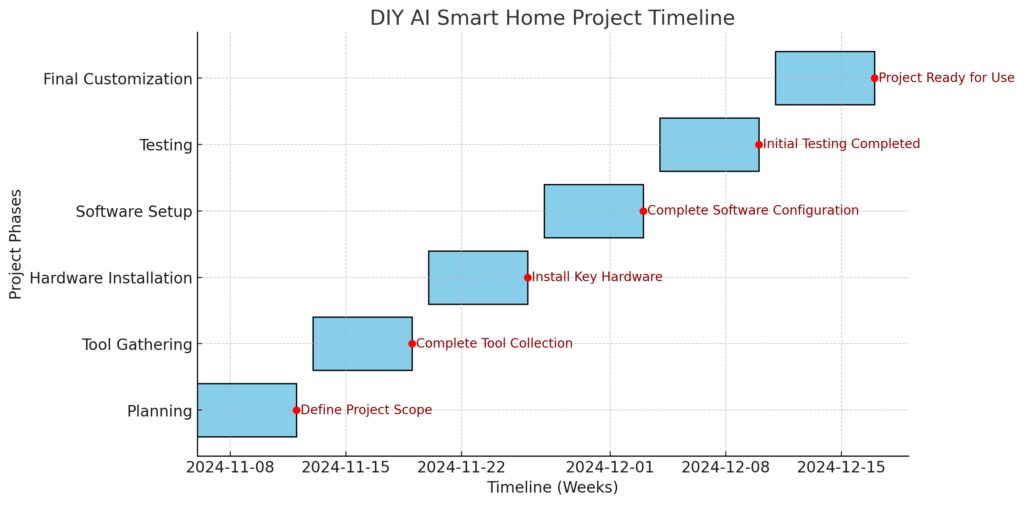
Weekly Phases:Planning: Define project scope.
Tool Gathering: Complete tool collection.
Hardware Installation: Install key hardware.
Software Setup: Complete software configuration.
Testing: Conduct initial testing.
Final Customization: Prepare the project for final use.
Milestones are marked with red dots and labeled to track progress, helping ensure each phase is completed on schedule. This layout provides a clear roadmap for managing project tasks efficiently.
FAQs
How can I use AI to make my home more energy efficient?
AI can help reduce energy consumption by optimizing appliance usage and automating systems like lighting and HVAC. You can connect AI to smart meters to track energy usage patterns, and program it to run high-energy appliances during off-peak hours. Additionally, AI can suggest energy-saving adjustments for lighting, heating, and cooling, resulting in lower utility bills and a more sustainable home.
What safety features can I add to my DIY AI home automation setup?
Home safety can be enhanced with AI-powered security cameras, motion sensors, and leak detectors. Using AI for facial recognition or anomaly detection allows your security system to differentiate between familiar and unknown faces, reducing false alarms. Motion sensors can alert you to unusual movement, while leak sensors can detect water or gas leaks, sending instant notifications to your phone.
How does an AI-powered thermostat work?
An AI-powered thermostat learns from your daily routines and preferred temperatures to keep your home comfortable while saving energy. It uses temperature sensors around your home to adjust settings automatically based on your habits. For instance, it might lower heating during the night or when no one is home, making adjustments over time as it learns your preferences.
Can AI help with pet care while I’m away?
Yes, AI can automate many aspects of pet care. You can set up automated feeders that dispense food at set times, use cameras to monitor your pet’s activity, and even track health metrics like weight. With motion sensors and AI, you can also receive notifications if your pet is less active than usual, giving you peace of mind while you’re away.
Are DIY AI projects costly?
The cost of DIY AI projects can vary, but many are surprisingly affordable, especially if you start small. Basic tools like Raspberry Pi kits and sensors are budget-friendly, and there are numerous free or open-source platforms available for project management, such as Home Assistant and TensorFlow Lite. You can expand gradually, adding more devices and capabilities over time as your budget allows.
Can I customize voice commands with AI?
Yes, you can create custom voice commands with AI, going beyond standard Alexa or Google Assistant functions. By using platforms like OpenAI’s Whisper or other voice recognition tools, you can teach your system to respond to unique phrases or commands. For instance, you could program specific commands to control lights, unlock doors, or initiate routines, all tailored to your preferences.
How can AI improve my home’s security?
AI significantly enhances home security through real-time alerts, anomaly detection, and facial recognition. With AI-driven cameras, you can differentiate between familiar and unfamiliar faces, receive alerts only when unusual activity is detected, and even get personalized notifications for each household member. Integrating geofencing can also automatically activate or deactivate security settings based on your location, giving you peace of mind without constant manual adjustments.
Can AI help me manage my indoor plants?
Absolutely! AI can help you create a smart gardening system indoors by monitoring key conditions like soil moisture, light exposure, and temperature. With sensors and a simple AI setup, you can automatically water plants when soil moisture levels drop and adjust indoor lighting to optimize growth. This setup is particularly useful for those with busy schedules, as it ensures plants receive consistent care without daily attention.
Is it possible to set up a personalized AI-powered assistant?
Yes, setting up a personalized AI assistant for your home is both possible and accessible. Using open-source platforms, you can create an assistant that’s entirely customized to your needs, from controlling lights and temperature to managing reminders and answering questions. You can even integrate this assistant with Home Assistant or a Raspberry Pi for a full DIY approach, making it a highly personal and functional addition to your smart home.
What kind of maintenance do DIY AI systems require?
While DIY AI systems don’t require intensive maintenance, periodic updates and checks are important to keep everything running smoothly. You may need to update software, recalibrate sensors, and ensure all devices are connected and functioning. Regularly checking device batteries and cleaning sensors can also help maintain performance. Additionally, updating your system with the latest security patches is key to protecting against vulnerabilities.
How does AI enhance home lighting systems?
AI can make lighting systems more energy-efficient and personalized. For example, motion sensors can automatically turn lights on and off based on room occupancy. AI algorithms can also adjust brightness and color based on the time of day or your mood, creating a customized ambiance. Some systems even learn your preferences over time, anticipating when and where you need light, saving energy, and adding convenience.
Can I use AI to monitor my health at home?
Yes, AI-enabled health monitoring systems can track various health metrics to support wellness at home. With wearable devices or sensors, you can monitor data like heart rate, sleep patterns, and activity levels. These systems can also provide personalized insights or alerts if they detect unusual patterns, which can be useful for individuals managing specific health conditions or seeking to improve their overall well-being.
What are some eco-friendly AI projects for a sustainable home?
AI offers several eco-friendly options to help reduce waste and conserve resources. For example, a smart irrigation system can conserve water by adjusting to soil moisture levels and weather conditions. Energy monitoring systems track and optimize electricity usage, automatically reducing power to unused devices. You can also set up AI to manage composting and waste sorting, ensuring materials are sorted correctly for recycling or composting, making sustainable living easier.
Resources
AI Platforms and Software
- TensorFlow Lite – A lightweight version of TensorFlow designed for mobile and IoT, ideal for integrating small-scale AI models in smart devices.
- OpenAI API – Great for text-based and voice assistant applications in home automation. OpenAI’s API enables natural language processing capabilities, making it easy to create custom commands.
- Home Assistant – An open-source platform for home automation that integrates with nearly any smart device. It’s well-suited for connecting and managing smart home devices.
- IFTTT – IFTTT (If This Then That) is a user-friendly automation platform that links smart devices through customized “recipes” without needing complex coding.
| Platform | Primary Uses | Key Features | Project Examples |
|---|---|---|---|
| TensorFlow Lite | Machine learning on edge devices | – Runs on low-power hardware – Image & speech recognition | – Image recognition with Raspberry Pi – Voice command processing |
| OpenAI API | Language processing & chatbot integration | – Advanced NLP – Customizable responses | – Smart assistant chatbot – Automated responses to queries |
| Home Assistant | Centralized control of smart devices | – Integrates with 1000+ devices – Open-source | – Voice control of lights – Energy monitoring dashboard |
| IFTTT | Connecting apps & devices for automation | – Cross-platform automation – User-friendly applets | – Automatic notifications – Smart thermostat control |
Summary:
- TensorFlow Lite: Ideal for edge-based machine learning in small-scale devices.
- OpenAI API: Excellent for natural language understanding and conversational AI.
- Home Assistant: Best for integrating and controlling diverse smart home devices.
- IFTTT: Simplifies cross-platform automation with pre-made applets.
